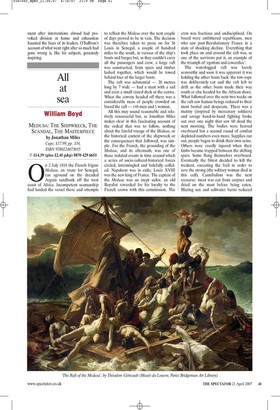All at sea
William Boyd
MEDUSA: THE SHIPWRECK, THE SCANDAL, THE MASTERPIECE by Jonathan Miles Cape, £17.99, pp. 334, ISBN 9780224073035 ✆ £14.39 (plus £2.45 p&p) 0870 429 6655 On 2 July 1816 the French frigate Medusa, en route for Senegal, ran aground on the dreaded Arguin sandbank off the west coast of Africa. Incompetent seamanship had landed the vessel there and attempts to refloat the Medusa over the next couple of days proved to be in vain. The decision was therefore taken to press on for St Louis in Senegal, a couple of hundred miles to the south, in various of the ship’s boats and barges but, as they couldn’t carry all the passengers and crew, a large raft was constructed, from spars and timber lashed together, which would be towed behind four of the larger boats.
The raft was substantial — 20 metres long by 7 wide — had a mast with a sail and even a small raised deck at the centre. When the convoy headed off there was a considerable mass of people crowded on board the raft — 146 men and 1 woman.
All this may sound reasonable and relatively resourceful but, as Jonathan Miles makes clear in this fascinating account of the ordeal that was to follow, nothing about the fateful voyage of the Medusa, or the historical context of the shipwreck or the consequences that followed, was simple. For the French, the grounding of the Medusa, and its aftermath, was one of those isolated events in time around which a series of socio-cultural-historical forces circled, intermingled and balefully collided. Napoleon was in exile; Louis XVIII was the new king of France. The captain of the Medusa was an inept sailor, an old Royalist rewarded for his loyalty to the French crown with this commission. The crew was fractious and undisciplined. On board were embittered republicans, men who saw post-Revolutionary France in a state of shocking decline. Everything that took place on and around the raft was, as one of the survivors put it, an example of the triumph of ‘egotism and cowardice’.
The waterlogged raft was barely seaworthy and soon it was apparent it was holding the other boats back: the tow-rope was deliberately cut and the raft left to drift as the other boats made their way south or else headed for the African shore. What followed over the next two weeks on the raft saw human beings reduced to their most bestial and desperate. There was a mutiny (inspired by mercenary soldiers) and savage hand-to-hand fighting broke out over one night that saw 60 dead the next morning. The bodies were heaved overboard but a second round of combat depleted numbers even more. Supplies ran out, people began to drink their own urine. Others were cruelly injured when their limbs became trapped between the shifting spars. Some flung themselves overboard. Eventually the fittest decided to kill the weakest, executing the frail in order to save the strong (the solitary woman died in this cull). Cannibalism was the next recourse: meat was cut from corpses and dried on the mast before being eaten. Blazing sun and saltwater burns reduced the survivors to demented animals. When the raft was eventually found there were only 15 men on board barely left alive.
To comprehend the nature of the ordeal of the raft of the Medusa requires a prodigious feat of imagination even today and the rebarbative example it provides of human venality and degradation is still mightily impressive. An account of the days on the raft by two of the survivors became a bestseller and was also political dynamite in the early and uncertain years of Louis XVIII’s creaking regime. Most famously it inspired Théodore Géricault to paint his vast masterpiece in 1819, a picture whose symbolic ramifications are expertly explored by Miles. Géricault’s romantic vision is far removed from the realities of the raft (too small, too many people, too healthy-looking, three black Africans when there was one and so on), but the power of the painting is strangely enduring and its influence on the course of European art was dramatic.
Géricault’s tormented soul found dis turbing resonances in the story of the raft (his emotional life was a shambles: a passionate affair with his married aunt had produced a child that had to be abandoned) but the events of those days in 1816 and their fall-out drew in all manner of major and minor figures and touched on many key issues of the time. The survivors fought their own demons — and battled with the state and each other — but somehow Géricault’s fraught engagement with his painting is the most haunting consequence of the Medusa story. He kept body parts from the local morgue in his studio and lived with the stench of putrefaction as he worked, the better to recreate the conditions of the raft, and shaved his head so he would not be tempted to go out in society. The painting made his reputation overnight but he died a few years later, inconsolable, unrequited, aged 32, from tuberculosis. His short life is so associated with the horrors of the raft of the Medusa that he might almost have been on it himself.



















































































 Previous page
Previous page